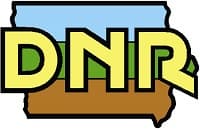Iowa Bow Hunters Gearing Up for 2013 Deer Season
Iowa Department of Natural Resources 09.25.13

Leading up to the Oct. 1 start to their season, Iowa bow hunters have been busy hanging stands, trimming shooting lanes and checking trail cameras. There has been some activity in the woods and field edges, with youth hunters and disabled hunters getting an early start in the pursuit of Iowa’s whitetails. Some urban and park management hunts are also underway now.
However, most of the 60,000 deer hunters expected to buy bow season tags climb into their stands, or blinds, in early October. Dealing again with another dry summer, there will be some adjustments in the early days. Deer will key in green food such as clover early as well as acorns as they begin to fall. Hunting food sources and along trails to them are very good early season strategies.
Scouting is helpful, especially as hunters pin down food sources. Some soybean fields were planted late, due to spring flooding and may still show a lot of “green.” With a bone-dry summer, many acres of corn were chopped for sileage. That has left fields bare that might otherwise have offered food and cover for deer and other wildlife. Fields planted to cover crops of rye or radishes might be a surprise bonus.
Acorns are also a primary source of food for fall whitetails. There are mixed reports on oaks this year in portions of Iowa. If white oak acorns are on the ground, they are most preferred by deer.
Most early season deer activity is tied to food. Bucks are more sedentary, feeding and putting on winter weight. Warm temperatures would keep them lying low until rut activities escalate. Towards late October, however, deer movement increases, building to the peak of the breeding season in mid-November.
Stay Safe Up There!
Ahead of the season, hunters should check their gear, as well as their stands. Falls associated with tree stand use are the most common hunting accident during the bow season. Stands and ladders should be tested to ensure they are solidly in place. Straps on stands and restraints on hunting harnesses should be solid and free of fraying or other wear and tear. With the solitary nature of bow hunting, it is important to let someone know where you are and when you expect to return.
Report that Harvest…
Any deer taken must be reported through Iowa’s harvest reporting system by midnight the day after the deer is tagged. The process takes only a couple minutes. Log on to the DNR website; www.iowadnr.gov or call the toll free reporting number at 800-771-4692. You can also file that report at any license vendor in Iowa. Accurate reports of deer harvested play a vital role in managing deer numbers and future hunting opportunities.
Other Prospects?
More than 50 deer management zone hunts have been established across Iowa. Hunting is underway in some of them. They range from urban areas, county and state parks and rural perimeters around cities where deer numbers have been too high in recent years. The hunts target antlerless deer, to help reduce doe numbers. Most are bow hunting only. Some offer the chance for a mentored hunt, pairing an inexperienced hunter with one who can pass along his or her experience.
EHD potential?
The potential effect of epizootic hemorrhagic disease (EHD) in local areas may also come into consideration. About 235 EHD reports have been received in the past weeks by DNR officials across 30 counties in southern and eastern Iowa. The deer were found dead, frequently near water. More reports could come as more hunters and others head into the fields and woods. A wider outbreak of the drought-driven disease was noted last year. The suspected EHD cases are a concern, though they are just a fraction of those reported last year in Iowa.

